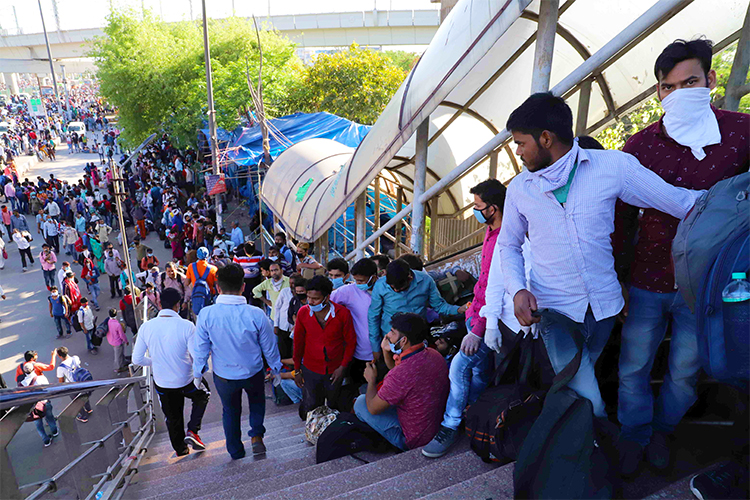Coronavirus & Indian youth

On the way to uncertainty: Youth are the worst hit by the corona pandemic in India (MIG photos/ Aman Kanojiya)
India’s youth population will be amongst the hardest hit due to the Coronavirus impact and cast a shadow over their already clouded future.
On Wednesday, Goldman Sachs, an American bank, yet again cut dramatically its prediction for the growth in Indian economy during the current fiscal to 1.6 pc due to the Coronavirus pandemic. That is a disastrous forecast for a country that is believed to grow at a minimum of 8 or 9 pc a year just to maintain its per capita income levels same.
In another dire prediction, the United Nations said on Tuesday that the Coronavirus could push as many as 400 million Indians into poverty. This essentially means that the pandemic and the lockdown could push back the Indian economy by as much as two decades. Incidentally, just last year, the UN had praised India for having lifted 271 million people out of poverty in a decade since 2005. But the latest prediction means that in terms of the number of poor, India could end up being back to the early 1990s.
The brunt of the impact of this catastrophic prediction would be borne by India’s young population, if for no other reason then just for the sheer numbers. Over 65 pc of India’s 1.35 billion people are below the age of 35 years and most of the, are either in education or looking for jobs or in temporary jobs. Even those with full time employment are working in the informal economy or micro and small industries. It is precisely this sector that the UN has warned of as being the most vulnerable and where the vast majority of layoffs are likely to have occurred or likely to occur.
The initial set of data about the first impacts of coronavirus pandemic on the Indian economy appears to be extremely gloomy. India’s unemployment rate surged to nearly 9 pc, highest in the last four years, according to data released by think-tank Centre for Monitoring Indian Economy (CMIE). It stood at 7.78 pc in February. There was a wide variation amongst states. While Tripura registered the highest rate of 29.9 pc, Puducherry’s unemployment rate was barely 1.2 pc, CMIE said. It went on to add that the number of unemployed people actively looking for a job stood at nearly 38 million, while those in employment was 43 million.
What is worrying that though the CMIE data looks bad enough, unfortunately it does not capture the entire picture of the lockdown and its impact on the implosion of the economy that followed once the lockdown was imposed on March 25. Hence, a much clearer picture would be visible only when the data for April is released. If the predictions of the UN and Goldman Sachs are any indication, India is headed for the worst economic crisis since its independence as never has the country registered a meagre 1.6 pc growth in its GDP or a large mass like 400 million people, or about 30 pc of its total population, pushed into poverty overnight.

Never ending queues: Few seats in good universities and fewer jobs have consigned Indian youth to long queues all their lives
But the impact of the pandemic on the youth is not just about jobs. Even those youth who are still in education find themselves facing an uncertain future. Educational institutions around the country were the first ones to be closed down following the outbreak. Tens of millions of students are yet to get any clarity over whether they can appear for their examinations and what would happen to their academic year in case the exams are cancelled.
A large number of them have few means to support themselves and their increasingly expensive education. Most of the students also take up part time jobs to earn a little bit to cover their living expenses. A rising number of them also carry large education loan that they have to begin repaying as soon as their education is over and they find a job.
The outbreak of the Covid-19 pandemic has hit this category of the society the hardest. With the country under a complete lockdown, hundreds of thousands of small and medium businesses across all sectors, but especially in hospitality, tourism, construction and several other aligned sectors have been shut and millions of workers, most of them young, face an uncertain future as even though the government has urged businesses not to lay off and continue to pay salaries to all employees, thousands of SMEs are expected to shut shop as they were already in a bad shape due to an ongoing economic crisis that has gripped the country for the past several months.
For many employers and workers, the current series of layoffs and economic crisis would have a sense of déjà vu. Over the last four years, the Indian economy has been hit two other shocks of monumental proportions. One was the ill-conceived idea of demonetisation in November 2016 that saw the entire cash disappear from what is still, mainly a cash driven economy. Barely a few months later, the government delivered another major blow in the form of terrible implementation of a tax reform with the introduction of the Goods & Services Tax, which was meant to ease business but ended up being such a headache for businesses that many are yet to recover.
Since then, the Indian economy has been in a turmoil and was still drifting lower when the coronavirus tsunami hit. It has led tens of millions of youth to suffer unprecedented hardship and uncertainty about what fate had in store for them. This is mainly because even though youth are often called the future of the country, the government did not pay attention to them nor bring in realistic policies to secure their future.
Unfortunate as it may be, but fate has presented another opportunity for the political leaders to do the right thing by the youth. As bailout packages are announced, it would be very crucial that they keep the future of the human race at the centre of their plans and not merely as an afterthought.









